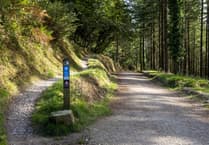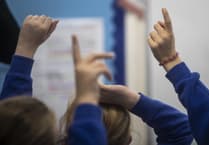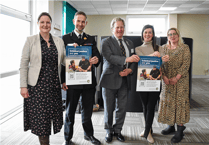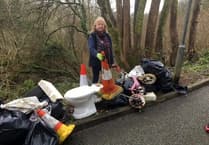Flicking through the pages of an appointments diary from 1982, David Hambly is trying to decipher the handwriting of his old boss and mentor, John Rapson.
It’s one of dozens of hardback diaries, filled in with various shades of ink or biro, that David has pulled out as he nears his own retirement. A page opens on a typical week: a Drama Group rehearsal, a Town Council presentation – photos commissioned by the Cornish Times. A portrait of a baby for a Mrs Wilson. A wedding at Menheniot, followed by the reception in The White Hart.
If you’ve lived in Liskeard or one of the villages for a long while, chances are you have a photo taken by David in a frame or a scrapbook somewhere: your school portrait, your wedding day, or maybe a carnival where your group’s float won a prize from the Lions.
“It’s just everyday happenings, really,” he says. But on reflection it’s this documenting of life and local happenings which has been David’s one abiding love, rather than a particular genre of photography.
I ask if any stand out in his mind. “It’s very difficult to pick out the most memorable ones. They all meant something because you’re capturing an event – a moment in time. People still often say to me ‘oh you know you photographed my parents’ wedding’. That’s been very special. If I had the time over, I think I’d do it again.”
David was born and has lived all his life in St Cleer. A childhood neighbour was a young Vivienne Westcombe, and while at the time they’d never have known it, Viv Twornicki, reporter, would become a long-standing colleague at The Cornish Times.
“I’d failed my 11 plus and so I went to the secondary modern school – at that time you left when you were 15, well actually I was 14 and three quarters. My dad found me the job – he knew Mabel Dennis who worked in Windsor Place and she’d told him John Rapson wanted an apprentice. I started in 1963. At that point, it was just a job: I’d not really had any interest in photography especially before that.”
It was a big change from school, says David: “I used to come home exhausted because I’d been on my feet all day long. The darkroom work was quite laborious. You’d be standing paddling prints around for many hours.”
As a youngster David absorbed the meticulous attention to detail and conscientious approach of his boss – but these hours in the darkroom weren’t necessarily his favourite at the time!
“With weddings usually on a Saturday we’d return to the studio and the first job was to warm up the large developer tank to the correct temperature. In total darkness, John would load the roll films into spirals and carefully place them into a rack ready to be submerged in the tank. This was a fiddly process and could not be rushed. Once the films were developed and placed in a second tank of fixer solution it was safe to put the light on and wash them in running water for 30 mins. After hanging the films up to dry we would be able to relax on the Sunday, knowing everything was alright.
“The following Monday morning would be spent making proof prints where the film images would be projected down onto photographic paper by means of equipment called an enlarger. This was carried out in yellow light conditions and once the prints were developed, fixed (in trays) and washed in a large tank, the prints were put through a rotating drying machine. The final stage was trimming and stamping, ready for the bride to collect a few days later.”
Gradually the young David was allowed more responsibility until the day came, aged about 17 or 18, when he was dropped at Tremar Coombe for his first solo job as a wedding photographer.
A photo depicts John by the car, the driver’s door hanging open, he looking warily to camera, clearly not sure whether to abandon the teenager to this important task!
“It was the most nerve-wracking time of my life, but it all went ok in the end,” David says.
“I did get one thing wrong. Traditionally, the groom stands next to his bride on her right hand side so that he can defend her with his sword! John would have reminded me about this many times, but I put the groom on the wrong side. Being the only mistake, though, it was ok, and I didn’t get the sack!”
It was to be the first of many hundreds of local weddings and occasions attended by David, from agricultural shows, jubilee picnics and theatrical performances to once-in-a-lifetime events like the Olympic torch coming through Liskeard, or the huge Man Engine lighting up the moor at Minions. “You might be called out one week to take photos of some pigs or bullocks, or you might get a booking for the Earl of St Germans’ wedding at Port Elliot, you never knew. To me the challenge was to do what was put before me: whatever came along I’d have a go.”
He has seen vast changes over six decades of working life.
“The revolution came when film became almost redundant and photography started to become digital. Kodak were actually the forerunners of this when they launched Photo CD. Customers could bring in negatives or transparencies to be sent to Kodak Processing where the images would be scanned and returned on a special CD to be viewed on a TV through a player. But they didn’t fully jump onto the ship and of course eventually went bust!”
“Colour photography arrived very gradually from the 1950’s onwards. One of the services offered was hand colouring carried out by a specialist photo lab in West Yorkshire. A black and white negative would be sent to the firm to make a print which an artist would hand colour with water colours, making the print suitable for framing, and also fade resistant. It was particularly popular for children’s portraits. To help the artist we would send colour details of eyes and clothes and sometimes pieces of a child’s hair so the final result would be as accurate as possible.”
As changes advanced, David and John would always keep customers abreast of the latest technology, with demonstrations of equipment at the studio, and a regular tips and tricks column in the local paper. David’s family were closely involved over the years: there’s a lovely photo of he and his daughters Andrea and Sharon at the Liskeard Show, bright and smiling in their yellow Kodak t-shirts and red hats, coloured balloons around the little stand.
Today photography feels completely different, says David: the value in 12 or 24 exposures from a roll, the anticipation of seeing your photos developed in print, has gone. “People are taking loads of pictures on their phones, but where are these images going? It’s made it much easier for people to record events, of course, but they don’t get printed out and put in family albums.”
When David started out at 15 he could not have predicted that he would take the reins of the business from John Rapson and that such a close familial bond would grow between the two men.
On his retirement in 1987, John entrusted the company to his one-time apprentice, and David built the shop and studio at its present site in the Cattle Market.
Now it is the turn of Hannah Crabb, who has worked for David for more than 20 years, to take the reins and bring her own identity, talents and strengths to a new era and new sorts of products.
This week, she’ll be at the helm in the Cattle Market studio now to be known as Smilers – incorporating David Hambly Photography.
“She’s incredibly good at digital artwork and restorations,” says David, “ and she’s a very talented artist in her own right.
“I have every confidence in her taking it forward as she’s been effectively running the business already since last March.”
David says that like anyone who has worked all their lives, it will “take me a while to get my head around retirement”.
“I shall look back on the good times. I want to thank all my customers past and present and most of all my dear wife Wendy, who has done the accounts and all the things behind the scenes that every business needs to succeed.”
David continues: “I tell people that John was a sort of father figure to me. He was so much more than a boss, and I still miss him.
“That’s why I am happy to pass the business on to Hannah. I know John would be very pleased as well.”




